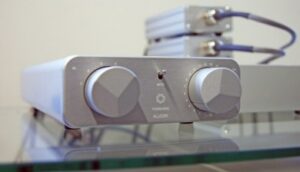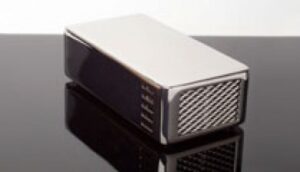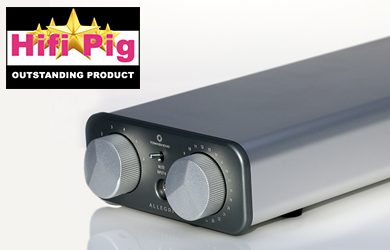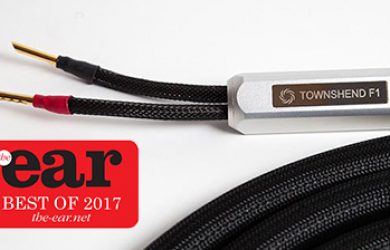“The Seismic Podiums become so fundamental to the listening experience that calling them mere accessories fails to give them enough credit.” Neil Gader – The Absolute Sound [ Full Review ]
Produce a wider and deeper sound stage.
• Improve bass definition.
• Eliminate structure-borne feedback between the speaker and vibration sensitive equipment.
• Allow for neighbour friendly high level listening.
• Eliminate irritating boom caused by coupling through the floor to adjacent rooms.
By using Seismic Isolation Bars, you will be able to enjoy your music at its natural volume level, – as if you were listening to a live performance – without annoying the neighbours!
To install, first, remove any spikes or cones from your speakers and slip one bar under the front of the speaker. Then tilt the speaker forward and slide the second bar under the rear. Very small adjustments allow for setting the speakers vertical. Even though the speakers are floating, it takes a very big push to topple them.
The Seismic Bars are available with five different weight range capacities, varying progressively from less than 5kg up to potentially over 75kg.
We strongly recommend using Seismic Podiums for loads above 30kg if single-handed, or up to 75kg for ease of use and stability reasons, especially on equipment taller than 1m and/or high center of gravity.
We suggest, for reasons of ease of set-up and loads that are not equally distributed, that consumers always select the stronger Load Cell where two values overlap in the graph below.
For example, when using four (4) type “C” Load Cells, the maximum supported weight should be equal to or less than 52.4 Kg, including the weight of the Podium base plate vibration into the speaker cabinet and thence to the speaker driver baskets where it is.
Seismic Isolation Bars are designed to break the acoustic connection between the speakers and the floor, thus preventing the passage of unwanted vibration between the two. Used in pairs under any speaker, be it floor standing, stand-mounted or sub-woofers.
Because of the very compliant nature of the Seismic Load Cells™, the speakers effectively float in the room at frequencies above 3Hz. Each bar comprises a very strong steel cross-piece with raised ends under which are attached two Seismic Load Cells™.
When installed you experience The Seismic Effect! The sound improves dramatically, with wider stage width and greater depth and the sound becomes independent of the speakers. Bass becomes tighter and more real, with thuddy boom greatly reduced. A major plus is that the sound of the speakers is no longer transmitted through the structure of the building with the same intensity, so your neighbours will probably not hear your music!
Conventional so-called rigid supports (spikes or cones) aim to hold the speaker cabinet ‘still’ at audio frequencies. However, there will be coupling between the speaker and the floor and myriad resonance set up by the mass of the cabinet reacting with the unavoidable springiness of the floor, which can cause vibration of the building structure in the audio band. Rigid coupling also transmits ground-borne vibration into the speaker cabinet and thence to the speaker driver baskets where it is superimposed onto your music.
To install, first, remove any spikes or cones from your speakers and slip one bar under the front of the speaker. Then tilt the speaker forward and slide the second bar under the rear. Very small adjustments allow for setting the speakers vertical. Even though the speakers are floating, it takes a very big push to topple them.
The Seismic Bars are available with five different weight range capacities, varying progressively from less than 5kg up to potentially over 75kg.
We strongly recommend using Seismic Podiums for loads above 30kg if single-handed, or up to 75kg for ease of use and stability reasons, especially on equipment taller than 1m and/or high center of gravity.
We suggest, for reasons of ease of set-up and loads that are not equally distributed, that consumers always select the stronger Load Cell where two values overlap in the graph below.
For example, when using four (4) type “C” Load Cells, the maximum supported weight should be equal to or less than 52.4 Kg, including the weight of the Podium base plate.


“With lab results at, or very close to, the state of the art..” Martin Colloms, Editor of HiFiCritic Magazine auditions the new Townshend Allegri Reference Preamplifier. [ Full Review ]
Professional musician and audiophile Rafael Todes “recommends without question” Max Townshend’s new Allegri Reference. “I never tired of this preamp’s ‘revelatory’ quality; everything you play somehow sounds different to before… …gives preamplifiers at any price and of any type, an almost impossibly hard time in terms of sound.” [ Full Review ]
“Townshend Audio has long been the company that never does it the way you expected, but always does it right. There’s a deliciously left-field approach to Townshend Audio’s design criteria that sweeps aside convention and makes something at once different and brilliant. So it is with F1 Fractal, the latest in a long line of […]
“The Allegri+ is one of the most effortless and honest sounds you will ever hear, with a top end that is as crystal clear as fine cut diamonds and has a bandwidth that stretches on for days. Play any of your favourite music and try and work out where all the added bass comes […]
The thoughts of one of the many reviewers who enjoyed the Townshend F1 Fractal Interconnect. “On the heels of the ridiculously superb (passive) Allegri+ preamplifier (HERE), with its secret sauce…fractal wire…comes the introduction to America of Townshend F1 Fractal Interconnects. (There are speaker cables also, but I did not have them for review.) The interconnects are extremely […]
Details |
|
|---|---|
|
Frequency response:
|
8Hz-100kHz +/- 0.1dB |
|
Maximum signal level:
|
4V RMS 8Hz; 10V RMS 20Hz |
|
Maximum DC offset :
|
5mV. (For undistorted 8Hz) |
|
Distortion:
|
Less than 0.01% at 400Hz, 10V (2nd and 3rd harmonic only) |
|
Input impedance is dependent upon the load impedance and gain setting. So, with a power amplifier having 20kohm input impedance (typical) |
|
|
Impedance:
|
At 0dB, input impedance is 20kohm |
|
Inputs:
|
At 0dB, input impedance is 20kohm. At -10dB (normal listening) input impedance is 200kohm, for a power amplifier load with 20kohm input impedance. |
|
Inputs:
|
6 pairs RCA phono sockets (gold plated)
One 3.5mm stereo socket on front panel.
|
|
Outputs:
|
2 pairs RCA phono sockets (gold plated) |
|
Width:
|
135mm (5.3in)
|
|
Height:
|
53mm (2.1in)
|
|
Depth:
|
326mm (12.8in) |
|
Weight:
|
2kg (4.4lb)
|
“The Seismic Podiums become so fundamental to the listening experience that calling them mere accessories fails to give them enough credit.”
“The way it removes the speaker’s interaction with its surroundings is mind blowing, bringing clarity to the entire frequency range that enables it to communicate more effectively with the listener. You haven’t truly heard how your speaker can perform until you’ve placed it on one of these. Enthusiastically recommended.”
“So what do Seismic Podiums do for sound quality? If I said “everything” you wouldn’t believe me, but the answer is not far off. They dramatically increase low level resolution so you can hear more detail, they clean up the bass like you wouldn’t believe and the improve dynamics and speed.”















